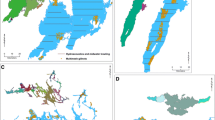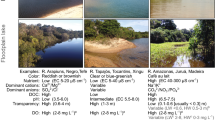Abstract
We evaluated water quality and fish assemblages in deep (>3.0 m; N = 7) and shallow (<1.5 m; N = 6) floodplain lakes in the intensively cultivated Yazoo River Basin (Mississippi, USA) using indirect gradient multivariate procedures. Shallow lakes displayed wide diel oxygen fluctuations, some reaching hypoxic/anoxic conditions for extended periods of time, high suspended solids, and extreme water temperatures. Conversely, deeper lakes were represented by higher visibility, stable oxygen levels, and cooler water temperatures. Fish assemblages in shallow lakes were dominated by tolerant, small-bodied fishes and those able to breathe atmospheric oxygen. Deeper lakes had a greater representation of predators and other large-bodied fishes. Our evaluation suggests fish assemblages are reflective of oxbow lakes water quality, which is shaped by depth. Understanding the interactions between depth, water quality, and fish assemblages may facilitate development of effective management plans for improving conditions necessary to sustain diverse fish assemblages in agriculturally dominated basins.





Similar content being viewed by others
References
Andrews CS (2013) Floodplain lake assessment and fish assemblage dynamics in the Mississippi Alluvial Valley. M.S. thesis, Mississippi State University
Andrews, C. S., L. E. Miranda, D. B. Goetz, R. Kröger (2014) Spatial patterns of lacustrine fish assemblages in a catchment of the Mississippi Alluvial Valley. Aquat Conserv. doi:10.1002/aqc.2468
APHA (1998) Standard methods for the examination of water and wastewater, 20th edn. American Public Health Association, American Water Work Association, Water Environment federation, Washington, DC
Baldwin DS, Mitchell AM (2000) The effects of drying and re-flooding on the sediment and soil nutrient dynamics of lowland river–floodplain systems: a synthesis. Regul Rivers Res Manag 16:457–467
Bayley PB (1995) Understanding large river: floodplain ecosystems. Bioscience 45:153–158
Bryant MD (2010) Past and present aquatic habitats and fish populations of the Yazoo-Mississippi Delta. US Department of Agriculture, Forest Service, Southern Research Station, Asheville, NC
Cooper CM, Knight JLA (1978) Fishes and water quality conditions in Six-mile lake, bear creek drainage, Mississippi. Proc Annu Meet Miss Chapter 2:27–36
Cooper CM, McHenry JR (1989) Sediment accumulation and its effects on a Mississippi river oxbow lake. Environ Geol Water Sci 13:33–37
Dake JMK, Harleman DRF (1969) Thermal stratification in lakes: analytical and laboratory studies. Water Resour Res 5:484–495
Dembkowski D, Miranda LE (2011) Hierarchy in factors affecting fish biodiversity in floodplain lakes of the Mississippi Alluvial Valley. Environ Biol Fish 93:357–368
Hamilton SK, Lewis W Jr (1990) Basin morphology in relation to chemical and ecological characteristics of lakes on the Orinoco river floodplain. Arch Hydrobiol 1:393–125
Junk WJ, Bayley PB, Sparks RE (1989) The flood pulse concept in river-floodplain systems. Can Spec Publ Fish Aquat Sci 106:110–127
Killgore KJ, Hoover JJ (2001) The effects of hypoxia on fish assemblages in a vegetated water body. J Aquat Plant Manag 39:40–44
Kushlan JA (1976) Environmental stability and fish community diversity. Ecology 57:821–825
Kwak TJ (1988) Lateral movement and use of floodplain habitat by fishes of the Kankakee river, Illinois. Am Midl Nat 120:241–249
Lizotte R, Shields F Jr, Knight S, Cooper C, Testa S, Bryant C (2011) Effects of artificial flooding on water quality of a floodplain backwater. River Res Appl 28:1644–1657
Magoulick DD, Kobza RM (2003) The role of refugia for fishes during drought: a review and synthesis. Freshw Biol 48:1186–1198
McCune B, Grace JB (2002) Analysis of ecological communities. MJM Press, Gleneden Beach, Oregon, USA
Miranda LE (2005) Fish assemblages in oxbow lakes relative to connectivity with the Mississippi River. Trans Am Fish Soc 134:1480–1489
Miranda LE (2011) Depth as an organizer of fish assemblages in floodplain lakes. Aquat Sci 73:211–221
Miranda LE, Lucas GM (2004) Determinism in fish assemblages of floodplain lakes of the vastly disturbed Mississippi Alluvial Valley. Trans Am Fish Soc 133:358–370
Miranda LE, Hargreaves JA, Raborn SW (2001) Predicting and managing risk of unsuitable dissolved oxygen in a eutrophic lake. Hydrobiologia 457:177–185
Miyazono S, Aycock JN, Miranda LE, Tietjen TE (2010) Assemblage patterns of fish functional groups relative to habitat connectivity and conditions in floodplain lakes. Ecol Freshw Fish 19:578–585
Murphy J, Riley JP (1962) A modified single solution method for the determination of phosphate in natural waters. Anal Chim Acta 27:31–36
Oksanen, J., F., G. Blanchet, R. Kindt, P. Legendre, P. Minchin, R., R. B. O’Hara, G. Simpson, L., P. Solymos, M. H. Henry, S. a. H. Wagner (2011) vegan:community ecology package. R package version 2.0-2. http://CRAN.R-project.org/package=vegan
Perrow M, Jowitt AD, Stansfield J, Phillips G (1999) The practical importance of the interactions between fish, zooplankton and macrophytes in shallow lake restoration. Hydrobiologia 395–396:199–210
Rodríguez MA, Lewis WM (1997) Structure of fish assemblages along environmental gradients in floodplain lakes of the Orinoco River. Ecol Monogr 67:109–128
Roozen FCJM, Van Geest GJ, Ibelings BW, Roijackers R, Scheffer M, Buijse AD (2003) Lake age and water level affect the turbidity of floodplain lakes along the lower Rhine. Freshw Biol 48:519–531
Roozen FCJM, Lürling M, Vlek H, Van Der Pouw Kraan EAJ, Ibelings BW, Scheffer M (2007) Resuspension of algal cells by benthivorous fish boosts phytoplankton biomass and alters community structure in shallow lakes. Freshw Biol 52:977–987
Ross ST (2001) Inland fishes of Mississippi. University Press of Mississippi, Jackson
Scheffer M (2004) Ecology of shallow lakes. Kluwer Academic Publishers, Dordrecht, The Netherlands
Shields DF Jr, Lizotte RE, Knight SS (2011) Spatial and temporal water quality variability in aquatic habitats of a cultivated floodplain. River Res Appl 29:313–329
Shormann DE, Cotner JB (1997) The effects of benthivorous smallmouth buffalo (Ictiobus bubalus) on water quality and nutrient cycling in a shallow floodplain lake. J Lakes Reserv Manag 13:270–278
Ward JV, Tockner K, Schiemer F (1999) Biodiversity of floodplain river ecosystems: ecotones and connectivity. Regul Rivers Res Manag 15:125–139
Ward JV, Tockner K, Uehlinger U, Malard F (2001) Understanding natural patterns and processes in river corridors as the basis for effective river restoration. Regul Rivers Res Manag 17:311–323
Winemiller KO, Tarim S, Shormann D, Cotner JB (2000) Fish assemblage structure in relation to environmental variation among Brazos river oxbow lakes. Trans Am Fish Soc 129:451–468
Wren D, Davidson G, Walker W, Galicki S (2008) The evolution of an oxbow lake in the Mississippi alluvial floodplain. J Soil Water Conserv 63:129–135
Acknowledgments
We thank the Mississippi Agricultural Forestry Experiment Station, U.S. Geological Survey, U.S. Army Corps of Engineers, and the Forest and Wildlife Research Center for their support. We also thank Seiji Miyazono and Brian Henning for their constructive reviews. Specimen collections were authorized under Mississippi State University’s Institutional Animal Care and Use Committee protocol number 08–034. Any use of trade, firm, or product names is for descriptive purposes only and does not imply endorsement by the U.S. Government.
Author information
Authors and Affiliations
Corresponding author
Rights and permissions
About this article
Cite this article
Goetz, D., Miranda, L.E., Kröger, R. et al. The role of depth in regulating water quality and fish assemblages in oxbow lakes. Environ Biol Fish 98, 951–959 (2015). https://doi.org/10.1007/s10641-014-0330-z
Received:
Accepted:
Published:
Issue Date:
DOI: https://doi.org/10.1007/s10641-014-0330-z




